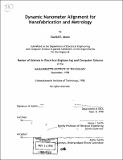| dc.contributor.advisor | Henry I. Smith. | en_US |
| dc.contributor.author | Moon, Euclid E. (Euclid Eberle), 1965- | en_US |
| dc.date.accessioned | 2008-05-19T16:18:49Z | |
| dc.date.available | 2008-05-19T16:18:49Z | |
| dc.date.copyright | 1998 | en_US |
| dc.date.issued | 1998 | en_US |
| dc.identifier.uri | http://hdl.handle.net/1721.1/41799 | |
| dc.description | Thesis (S.M.)--Massachusetts Institute of Technology, Dept. of Electrical Engineering and Computer Science, 1998. | en_US |
| dc.description | Includes bibliographical references (leaves 163-164). | en_US |
| dc.description.abstract | Future generations of IC fabrication depend in part on continued improvements in lithography. To meet the lithographic challenges posed by 25- nm lithography, a novel through-the-mask, interferometric imaging alignment method is described that has demonstrated detectivity below 1 nm. Approximately x-ray alignment and exposure system was constructed which incorporates this "Interferometric Broadband Imaging" (IBBI) alignment scheme. 18BI employs complementary grating and checkerboard-type alignment marks on mask and wafer, respectively. Interference fringes are imaged onto a CCD camera when viewing the marks at a Littrow angle of 15 degrees. Alignment is signified by the spatial phase discontinuities between two identical sets of interference fringes that move in opposite directions as the mask is translated relative to the wafer. The robustness of IBBI was verified by demonstrating that the relative spatial phase is not affected when overlayers of resist, polysilicon, or aluminum cover the alignment marks. Further verification of robustness was found when the illuminating and viewing beams traversed long optical paths through air, glass, and helium. It is significant that JBBJ measurements are made external to a helium enclosure through the above optical paths, since this allows continuous observation of alignment during exposure. Feedback stabilization was developed to nullify the effects of thermal drift and mechanical disturbances during exposure. Over several hours the relative position of the mask and wafer was demonstrated to be locked to within [sigma]=1.4 nm. | en_US |
| dc.description.statementofresponsibility | by Euclid E. Moon. | en_US |
| dc.format.extent | 164 leaves | en_US |
| dc.language.iso | eng | en_US |
| dc.publisher | Massachusetts Institute of Technology | en_US |
| dc.rights | M.I.T. theses are protected by
copyright. They may be viewed from this source for any purpose, but
reproduction or distribution in any format is prohibited without written
permission. See provided URL for inquiries about permission. | en_US |
| dc.rights.uri | http://dspace.mit.edu/handle/1721.1/7582 | en_US |
| dc.subject | Electrical Engineering and Computer Science | en_US |
| dc.title | Dynamic nanometer alignment for nanofabrication and metrology | en_US |
| dc.type | Thesis | en_US |
| dc.description.degree | S.M. | en_US |
| dc.contributor.department | Massachusetts Institute of Technology. Department of Electrical Engineering and Computer Science | en_US |
| dc.identifier.oclc | 42306235 | en_US |
